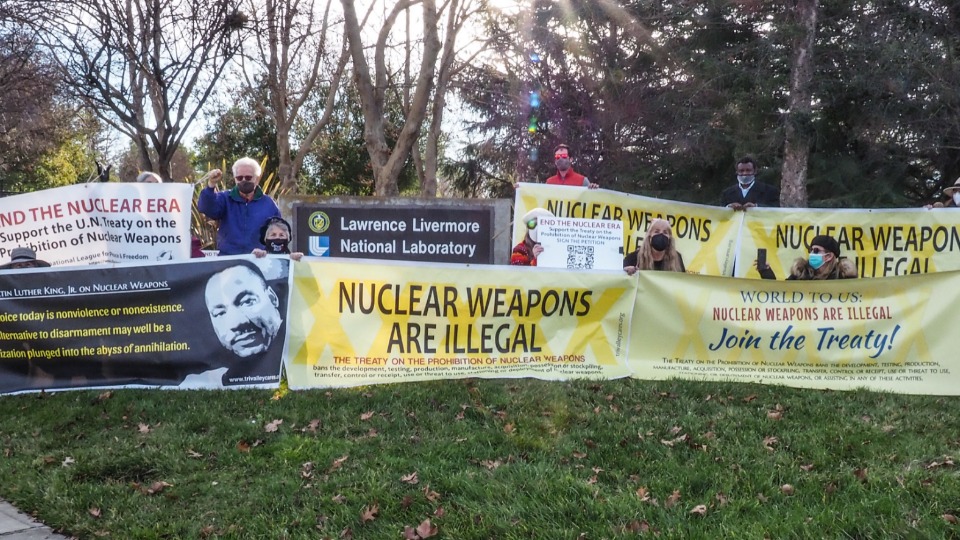
LIVERMORE, Calif. – As workers entered the west gate of the Lawrence Livermore National Laboratory on the morning of Jan. 21, they were greeted by protesters displaying 8-foot banners declaring, “World to U.S.: Nuclear Weapons are Illegal – Join the Treaty!”
The demonstrators, from Tri-Valley Communities Against a Radioactive Environment, Women’s International League for Peace and Freedom, and the Livermore Conversion Project, were there to celebrate the first anniversary of the Treaty on the Prohibition of Nuclear Weapons, and to call on the United States to sign and ratify the treaty. The pact, often called the “Ban Treaty,” entered into force on Jan. 22, 2021, after 50 nations had ratified it.
The protesters gathered at Livermore Lab because it is one of two locations that create every nuclear warhead and bomb in the U.S. stockpile.
After years of work by the International Campaign to Abolish Nuclear Weapons, the TPNW was adopted at a United Nations conference in 2017 by 122 of the UN General Assembly’s 192 members. The treaty has now been signed by 86 countries and ratified by 59, with more ratifications in process. So far, none of the world’s nine nuclear-armed nations have signed it, and three – the U.S., the United Kingdom, and France – have declared they will never ratify it.
The treaty bars its signatories from developing, testing, producing, manufacturing, transferring, possessing, stockpiling, using or threatening to use nuclear weapons, or allowing them to be stationed on their territory, or helping, encouraging, or pressing anyone to do so. It also commits them to aid victims of nuclear testing and to help restore contaminated sites.
As Raiza Marciscano, Tri-Valley CAREs’ community organizer, circulated a bullhorn among the banner-holding protesters, they told why they joined the early-morning action. Said one, “Nuclear weapons are as great a threat as the climate crisis and the extinction crisis. We need our government to sign the treaty and disarm and shift the money to human needs and protecting nature.”
Added another, “I’m here for all the survivors of our bombings – we’re the only nation to bomb a civilian population with a nuclear device – and to tell our young people to work for peace and nuclear disarmament.”
Noting that U.S. mainstream media have largely ignored the treaty, Scott Yundt, Tri-Valley CAREs’ staff attorney, declared that with 59 states having ratified the pact, “it’s time for us to take it seriously … Let’s do it!”
The bullhorn continued to circulate as participants read portions of the treaty. They joined in cheering, ringing bells, and chanting “United States, sign the treaty!” as Tri-Valley CAREs Executive Director Marylia Kelley read the names of ratifying countries. “This is the goal of the world,” Kelley said. “We’ve heard island countries, countries from almost every continent, countries of various sizes, various traditions.” She said all, including those still in the process of ratifying, are united to ensure nuclear weapons are never used again, by assuring their global abolition.
Wrapping up the action, the protesters zip-tied a banner featuring the treaty’s full text to the laboratory’s fence.
The action at Livermore Lab was one of many such anniversary gatherings around the world. Among dozens of other locations where advocates calling for U.S. ratification: Northampton, Mass.; Geneseo, N.Y., New York City; Asheville, N.C.; Madison, Wisc., Berkeley, Calif., and Idaho Falls, Idaho.
The very first nation state to ratify the Treaty on the Prohibition of Nuclear Weapons was the Vatican. On Sept. 20, 2017, the Secretary for the Holy See’s Relations with States signed the treaty at UN Headquarters in New York and at the same time, handed over the instruments of ratification.
As the TPNW’s first anniversary approached, Roman Catholic Archbishop John C. Wester of Santa Fe, N.M. on Jan. 11 issued a pastoral letter in which he called for renewed emphasis on nuclear arms control and on concrete steps to abolish nuclear weapons and to “find a new path toward nuclear disarmament.”
Archbishop Wester said the archdiocese “has a special role to play” in work for nuclear disarmament because of the presence of the Los Alamos and Sandia nuclear weapons laboratories and the U.S.’ largest repository of nuclear weapons at the Kirtland Air Force Base in Albuquerque, N.M.
Citing Pope Francis’ declaration that “We must never grow weary of working to support the principal international legal instruments of nuclear disarmament and non-proliferation, including the Treaty on the Prohibition of Nuclear Weapons,” Archbishop Wester said it is the duty of the archdiocese, “the birthplace of nuclear weapons, to support that Treaty while working toward universal, verifiable nuclear disarmament.”

And on Jan. 19, anticipating both the TPNW anniversary and the Biden administration’s expected release of its Nuclear Posture Review, Veterans For Peace released a far-reaching Nuclear Posture Review of its own, calling on the Biden administration to sign and ratify the TPNW and “to work with other nuclear-armed states to eliminate all the world’s nuclear weapons.
Veterans For Peace calls for a No First Use/No Launch on Warning policy with warheads separated from delivery vehicles, decommissioning of intercontinental ballistic weapons and silos because as well-known targets they can only be used as first-strike weapons, replacing the president’s sole authority to launch a nuclear attack with a more collective process less likely to lead to a rash decision, and eliminating anti-ballistic missile systems.
The Veterans urge Washington to reinstate the Anti-Ballistic Missile and Intermediate-Range Nuclear Forces Treaties, to ratify the Comprehensive Test Ban Treaty, and to call on the other nuclear powers to negotiate for nuclear disarmament under the 1970 Nuclear Nonproliferation Treaty. They also urge the U.S. to rejoin the Iran Nuclear Deal and negotiate a peace treaty with North Korea that will finally end the Korean war.
VFP also calls on the U.S. government to remove U.S. nuclear weapons stationed abroad, end all nuclear weapons modernization, create funding and develop technologies for cleaning up uranium mines and mills, nuclear production and testing facilities, and help nuclear industry workers transition to constructive employment.










